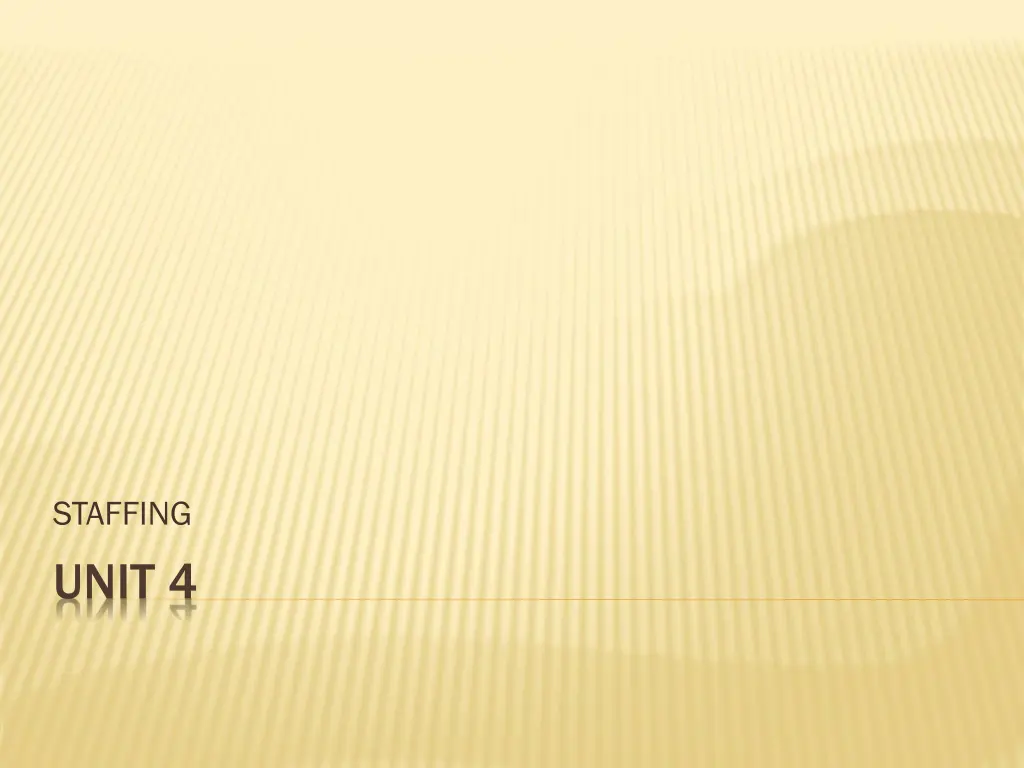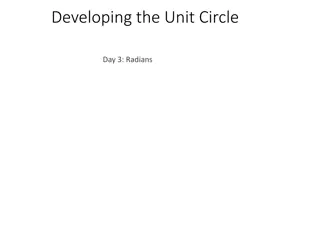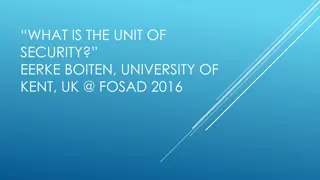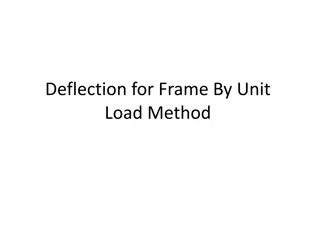
Understanding Staffing and Motivation in Organizations
Learn about the importance and functions of staffing in organizations, along with the significance of motivation in driving employee performance. Explore the nature of staffing, its role in manpower planning, and different methods of motivation used in the workplace.
Download Presentation

Please find below an Image/Link to download the presentation.
The content on the website is provided AS IS for your information and personal use only. It may not be sold, licensed, or shared on other websites without obtaining consent from the author. If you encounter any issues during the download, it is possible that the publisher has removed the file from their server.
You are allowed to download the files provided on this website for personal or commercial use, subject to the condition that they are used lawfully. All files are the property of their respective owners.
The content on the website is provided AS IS for your information and personal use only. It may not be sold, licensed, or shared on other websites without obtaining consent from the author.
E N D
Presentation Transcript
STAFFING UNIT 4
Staffing Staffing refers to assigning men to the organisation structure Staffing involves determination of man-power requirement, recruitment, selection, placement, training, development, job transfer and performance appraisal.
Nature of staffing Staffing function ensures that results are achieved through others. It avoids the following functions - Hiring the wrong person for the job - Wasting time and money in selection of employees - Having the company taken to court - Lack of training which undermines department effectiveness
Importance and need fo staffing The importance of staffing is a separate function and involves the following 1. Practicing managers think organizing as just setting up a structure 2. It brings together the human assets and organizational design 3. Emphasis on procuring and maintaining Human resources 4. It is the quality of manpower that determines the efficiency
Functions of ManPower Planning The following are the functions of manpower planning 1. It helps to identify the talent and potential of employees 2. Matching the job and the person 3. Ensures right number of people which helps in the smooth flow of activities 4. It ensures proper utilisation of human resources 5. Gives an idea for the internal succession of managerial positions
Manpower planning process The steps related to Human resource planning process are Demand forecasting estimating the future needs of human resources as per company s plans 2. Supply forecasting estimating the supply of human resources from the recruitment pool 3. Determining Human resource requirements 4. Productivity and cost analysis of Human resources with respect to utilization and cost. 5. Action planning of the necessary programmes of recruitment, selection, training and development etc 6. Human resource budgeting and control 1.
MOTIVATION Motivation is the inner state that causes an individual to behave in a way that ensures accomplishment of some goal Generally two methods of motivation are used to motivate people 1. Financial motivation and 2. Non-financial motivation
Importance of Motivation 1. Increases performance level 2. Adaptability to changing organizational climate 3. Lower turnover of employees 4. Effectiveness of performance on the job.
Theories of Motivation The important theories of Motivation are 1. Maslow s need Hierarchy 2. Herzberg s Two Factor theory 3. Achievement Motivation theory 4. ERG theory 5. Expectancy theory 6. Equity theory 7. Reinforcement theory 8. McGregor s theory X and theory Y.
Self actuali zation Estee m Needs Social Needs Safety Needs Physiol ogical Needs
2. HERZBERGS TWO FACTOR THEORY Two factor responsible for motivation are 1. Satisfiers or motivators and 2. Hygiene factors or maintenance factors or dissatisfiers Hygiene factors Motivators Company policy Supervision Relationship with supervisors Work condition Salary Relationship with co-workers Achievement Recognition Work itself Responsibility Advancement Growth
3. ACHIEVEMENT MOTIVATION THEORY Main elements of this theory are 1. Need for achievement 2. Need for power and 3. Need for affiliation
4. ERG THEORY Clayton Alderfer formulated a needs-category model in line with empirical evidence. Like Maslow and Herzberg, Alderfer felt that there was a basic distinction between lower-order needs and higher order needs. Alderfer identified three groups of core needs: Existence Needs: They are concerned with survival [physiological well being] Related needs: They stress the importance of interpersonal and social relationship. Growth needs: They are concerned with the individual s intrinsic [inner] desire for personal development.
5. EXPECTANCY THEORY This approach has three elements 1. Performance outcome expectancy 2. Valence 3. Efforts performance expectancy
6. EQUITY THEORY The essence of this theory is that employees working in organizations make comparisons of their efforts and rewards with others. This theory is based on three assumptions that all should be treated equally in terms of justice, balance and fairness.
7. REINFORCEMENT THEORY This theory emphasis four aspects Stimulus Response Consequence and future
8. McGREGORS THEORY X AND THEORY Y. After observing how managers deal with their employees, Douglas McGregor proposed Theory X and Theory Y. According to McGregor, Theory X assumes that employees dislike work and responsibility and they are also lazy. They must be coerced to perform. Theory Y assumes that employees like work, they are creative, seek responsibility and can exercise self direction.
MORALE Morale has different meanings Mayo defined Morale as the maintenance of cooperative living The components of morale are 1. Intrinsic job satisfaction 2. Satisfaction with the company 3. Satisfaction with supervision 4. Satisfaction with rewards 5. Satisfaction with co-workers
The factors affecting Morale 1. The organisation 2. Leadership 3. Co-workers 4. The nature of work 5. Work environment 6. The employee
Morale building 1. Remuneration 2. Job security 3. Participation 4. Job enrichment 5. Organisation structure 6. Grievance redressal 7. Employee counsellors 8. Sound leadership
LEADERSHIP According to Stephen P. Robbins Stephen P. Robbins, leadership is the ability to influence a group towards the achievement of a vision or set of goals.
Manager characteristics Leader characteristics Administers Innovates Acopy An original Maintains Develops Focuses on systems / structure Focuses on people Relies on control Inspires trust Short range view Long ranges view Asks how and when Asks what and why Eye on the bottom line Eye on the horizon Imitates Originates Accepts the status quo Challenges the status quo Classic good soldier Own person Does things right [efficient] Does the right thing [effective] Orders Coaches / advises Authority Confidence / goodwill Fear Enthusiasm Finding fault Solving problems Assumes he knows all Consults / seeks advice Makes work drudgery Work is a game Believes in I Believes in we and you
Qualities of a leader Qualities of a leader can be explained base on the traits and skills required by the leader
Trait characteristics of successful leaders 1. Adaptability to changing situations 2. Alertness to changing social environment 3. Ambitious and achievement record 4. Assertiveness 5. Reliable and dependable 6. Desire to influence 7. Self confidence 8. Ability to cope with stress 9. Willing to take up responsibility and accountability
Skills required by successful leaders 1. High influence 2. Persuasive 3. Personal, impersonal and negotiation skills 4. Creative 5. Diplomatic and tactful 6. Excellent communication skills 7. Administrative capability 8. Be able to identify problems
FUNCTIONS OF A LEADER 1. Leader develops network 2. Leader is a representative of the subordinates 3. Leader is an appropriate counsellor 4. Leader uses power properly 5. Leader uses time well 6. Leader strives for effectiveness
IMPORTANCE OF LEADERSHIP 1. inspires employees 2. Secures cooperation 3. Creates confidence 4. Provides good working climate
LEADERSHIP STYLES `The behaviour exhibited by the leader during the supervision of subordinates is known as leadership style. Basically there are three leadership styles 1. Directive, Autocratic or Authoritarian 2. Participative or democratic style and 3. laissez-faire or Free-rein leadership






















